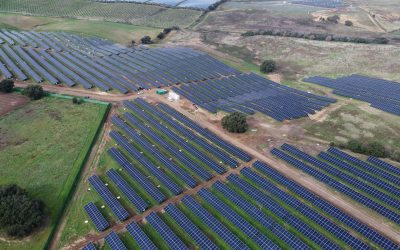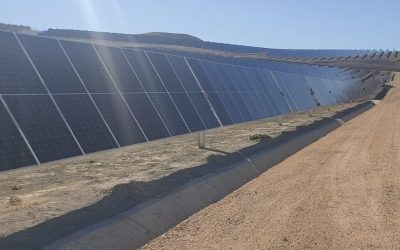Francesc Filiberto, Head Solar Development and Interim Managing Director BNZ
Glennmont Partners from Nuveen, the European leader in clean energy fund management, launched BNZ, a new independent power producer (IPP) last September with the aim of developing, building and managing solar photovoltaic energy projects in Southern Europe. Currently, BNZ has a pipeline in excess of 1.5 GW of European solar investments under development between Italy, Portugal and Spain by 2024, 350 MW of which are in the advanced development phase by Glennmont, with two projects in central Italy that have already been fully permitted.
Clean energy is in BNZ’s DNA and our approach is to establish partnerships with local organizations and communities, working in compliance with the regulations of the different countries in which we operate in order to provide clean energy that we can define as “electricity of proximity”, benefiting not only users but also the territory through the decarbonisation of the energy generation. One of our objectives is to have a positive impact on local communities, for example, not triggering land use change away from local agriculture, but implementing agrivoltaic practices according to a model that contemplates the production of photovoltaic solar energy, integrating it with local agricultural practices and traditions.
Glennmont has been working on the Italian market since 2010 and this allows us to look at the market in this country with a long-term perspective and to compare it to other markets. A key differentiator of the Italian “green” energy market is that the grid connection process is more transparent and better regulated than in other nearby countries. It is an evolving market characterized by a high penetration of clean energy assets and sees the presence of many processes that are also implemented by other players.
Market regulation
The Italian regulatory framework has many positives, one of these is the single authorization process, but also the service conferences, which allows all the relevant bodies to comment and give indication on specific projects in a very well-structured manner. The TSO’s authorization procedure is also a positive fact compared to other Southern European countries. Where we see areas for improvement is in the regulation of connections and in the complexity of the Italian legal system, which can cause delays in the implementation of the processes due to the appeals that are often made. However, the new Government has started a simplification process, which is expected to produce results in a couple of years. Also, at the local level, some regions are quicker to seize opportunities than others, because the degree of acceptance of renewable energy plants in different regions and municipalities is also different.
A significant differentiating factor for the Italian market compared to others in Southern Europe lies in the fact that the opinion of individual municipalities is factored into the single authorization process and represents one of the opinions on the matter; for example, this does not happen in Portugal, where a mayor has the power to authorize or deny a project. The Italian context enables the conditions for creating local energy communities that embrace multiple local administrations of a territory and this allows us to contribute to local economies earlier, as long as we can negotiate authorizations and implement projects with more agility.
BNZ’s goal is to create efficiency in the electricity system, good and stable grid connections and stability of the network we aim to achieve while complying with the National Grid code rules. We are starting from an excellent point and we are proactively creating synergies with all the critical project and regulatory partners; in the future there will be many new projects with different players on the market and we are certain that the most efficient way of implementing new projects is to collaborate to optimize these initiatives.
Normally, when BNZ implements a project, we commit to coordinating the activities connected to it, this involves collaborating on grid connections, selecting the teams that will implement electrical substations, identifying the territories on which to establish the connections, etc. In doing this we try to optimize the main solar PV production plant, thus making the substations more efficient. BNZ creates agreements with various parties so that the substations are connected as much as possible on the national territory and we see in this way of working the future direction of the development of solar photovoltaics in Italy.
Speaking of efficiency, we often talk about finding a compromise between the greater efficiency of a large production plant with the simplicity of creating a greater number of smaller plants. One way to address the issue is to find a system of connections between plants that allow you to maintain efficiency without having to invest in large plants, which significantly affect the area.
In Italy the regulations are becoming more and more sophisticated in this sense; in developing a long-term strategy, the impact of the project is key, and the regions and local administrations are now educated on how to develop a distributed electricity system capable of promoting several smaller projects and overcoming the regulatory constraints associated with a great plant.
Attractive projects
Once the development phase is over, the plant must be up and running and there are several options to consider for it to be attractive. At BNZ we believe that the current Power Purchase Agreement (PPA) market is rapidly evolving. If we think of advanced markets such as Germany, The United Kingdom and Spain, Italy is approaching these levels and the market is becoming more sophisticated; an option to consider may therefore be that of hybrid photovoltaic generation plants, associated with storage solutions. In our experience on the Italian market, traders who have projects in place that involve storage can strengthen their position when negotiating PPA contracts. In today’s market, a contract that includes multiple services or the ability to intervene in the market is, from a manufacturer’s point of view, ideal.
As for BNZ, our initial goal is to start building photovoltaic plants integrated with battery storage, and combined with wind power at a later stage. A benefit of solar power is that the window of time when it is generating is well known, predictable and shiftable with the help of storage. Solar power does not produce outside the sunlight hours, whereas the resource of wind power can be available 24 hours per day depending on the location. This results in a complimentary sharing of grid integration between solar and wind on a daily basis as well as on a seasonal basis. This integration has not yet taken place in Italy, but now is certainly a good time to start considering this.
Many projects are currently under development and at this very moment we see a bottleneck in the regulatory process. However, there are projects that will be interconnected over the next 5 years. We must also take into account the EU strategy on climate change and the legislative package “Fit to 55”, which calls for a European agenda on decarbonisation reducing greenhouse gas emissions by at least 55% by 2030. At this time, 75% of total greenhouse gas emissions in the EU comes from the energy sector, generating only 19.7% (in 2019) of total energy from renewable sources. We celebrate the latest updated target of 40% by 2030, 8 points more than the first goal. In this scenario, the role of companies such as BNZ is key: there are multiple capacity tenders and they will be essential to understand which path Italy will take on its way towards a green change.
If a system has storage capacity, the energy supply can be regulated by aligning better with the energy demand. By storing it, it is therefore possible to better exploit the energy produced by delivering it when it is most required without waste. For this reason, we believe that the authorities should not only focus on capacity tenders, but also support the players in the plant sector to give them the possibility to implement new storage technologies.
Ultimately, we are experiencing a moment of dramatic transformation in the Italian electricity market that offers important opportunities for those operators who are willing to invest in innovative technologies and collaborate with institutions, local authorities and market partners to implement projects capable of creating efficiency in the production of clean energy for the benefit of the market, users and the communities in which we work. The key objective of decarbonizing our economy and our energy production is the catalyst for this dramatic transformation in the electricity mix, something that gives great importance to renewable energy and offers a great opportunity to producers.


